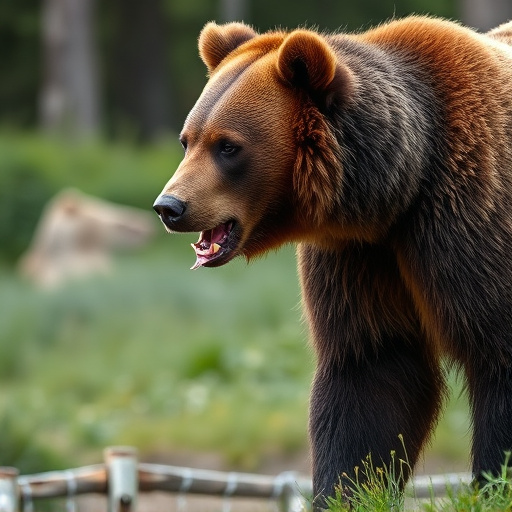The effective range of bear spray isn't a straight line but a zone influenced by wind, weather, terrain, user skill, and bear behavior, with 30 feet being the optimal distance for maximum deterrence. To use bear spray effectively (Best Distance for Bear Spray Effectiveness), aim directly at the bear's face or eyes from a slight downward angle, stay calm, keep the can ready, and practice in various conditions. At 30 feet, you can temporarily blind and disorient the bear, giving yourself time to retreat or defend during encounters in bear country.
In many outdoor adventure hotspots, understanding bear spray effectiveness is crucial for safety. We often hear it can reach a ‘thirty-foot range,’ but what does that mean? This article delves into the intricacies of bear spray range and factors that go beyond the stated 30 feet. We’ll explore best practices to maximize impact and real-world scenarios where this knowledge is vital, ensuring you’re prepared with the most effective tool at close ranges—the best distance for bear spray effectiveness.
- Understanding Bear Spray Range: What Does 'Thirty Feet' Really Mean?
- Factors Influencing Bear Spray Effectiveness Beyond Range
- Best Practices for Maximizing Bear Spray Distance and Impact
- Real-World Scenarios: When and How to Use Bear Spray within Thirty Feet
Understanding Bear Spray Range: What Does 'Thirty Feet' Really Mean?
Bear spray, also known as bear repellent, is a valuable tool for hikers and outdoor enthusiasts navigating bear-inhabited areas. When we say that bear spray has an effective range of thirty feet, it’s crucial to understand what that actually means in practical terms. The distance doesn’t refer to a precise, straight-line measurement but rather the optimal range for the spray to reach and deter aggressive bears.
In reality, the spray forms a mist or cloud that spreads out from the user, creating a protective zone. At thirty feet, the spray can cover a small area, offering protection while you retreat or assess the situation. It’s important to remember that factors like wind direction, weather conditions, and terrain can all affect how far the spray travels, so staying within this recommended range ensures maximum effectiveness as the spray will more reliably reach the bear and create an effective barrier.
Factors Influencing Bear Spray Effectiveness Beyond Range
The effectiveness of bear spray extends beyond just its stated range of thirty feet. Several factors play a crucial role in ensuring its success as a deterrent. The best distance for bear spray effectiveness isn’t solely about how far it can reach; it’s also about understanding when and where to deploy it. Environmental conditions like wind speed and direction significantly impact the spray’s trajectory and dispersion, potentially reducing its reach or causing it to blow back towards the user.
Additionally, the type of bear spray, user proficiency, and the bear’s behavior all contribute to its overall effectiveness. Using the spray correctly, at close range when a bear is displaying aggressive or defensive behavior, increases its chances of successfully deterring an attack. Different bears may also have varying reactions to the spray based on their age, size, and previous experiences, which can further influence the best distance for optimal effectiveness.
Best Practices for Maximizing Bear Spray Distance and Impact
When using bear spray, understanding the best distance for its effectiveness is key to staying safe in potential encounters. The optimal range for bear spray to be impactful is around thirty feet—the maximum reach of most cans designed for bears. To maximize this distance and ensure the spray reaches the bear effectively, users should aim directly at the bear’s face or eyes from this range. The can’s nozzle should be pointed at a slight downward angle to account for any wind or upward movement of the bear.
Practicing proper technique before an encounter is crucial. This includes ensuring the user is familiar with the spray’s mechanism and has practiced spraying in different weather conditions, as wind can significantly affect the spray pattern. Keeping the spray can ready and within easy reach during outdoor activities in bear country is also essential. Additionally, staying calm and not running or making sudden movements when a bear is spotted can help maintain the thirty-foot range, giving you time to deploy the spray effectively.
Real-World Scenarios: When and How to Use Bear Spray within Thirty Feet
In real-world scenarios, bear spray is most effective when used within the optimal range of thirty feet. This distance allows for precise application, ensuring the spray reaches the bear’s face and eyes directly. When facing a bear encounter, the best practice is to remain calm and assess the situation. If the bear has not noticed you, use this moment to slowly retreat while keeping an eye on its movements.
At thirty feet, you can effectively deploy the spray by aiming for the bear’s face as it charges or when it makes sudden movements. The spray creates a barrier of capsaicin, temporarily blinding and disorienting the bear, providing you with valuable time to escape or defend yourself. Remember, timing is crucial; using bear spray at this distance enhances your chances of deterring an attack and ensuring your safety in potentially dangerous bear country.
The optimal distance for bear spray effectiveness is thirty feet, but understanding how various factors can influence this range is key. By knowing what ‘thirty feet’ actually means and implementing best practices, individuals in grizzly country can maximize the impact of their bear spray. Recognizing real-world scenarios where bear spray is most effective within this range, as discussed in this article, empowers outdoor enthusiasts and locals alike to protect themselves and coexist safely with bears.
